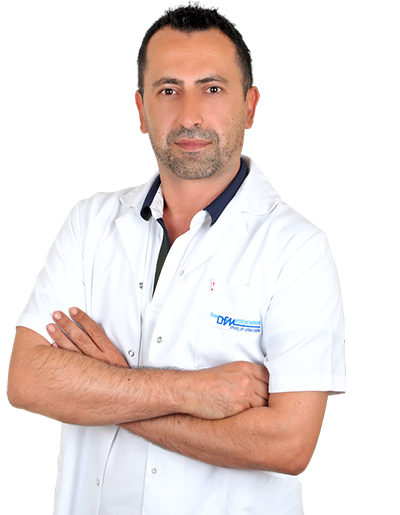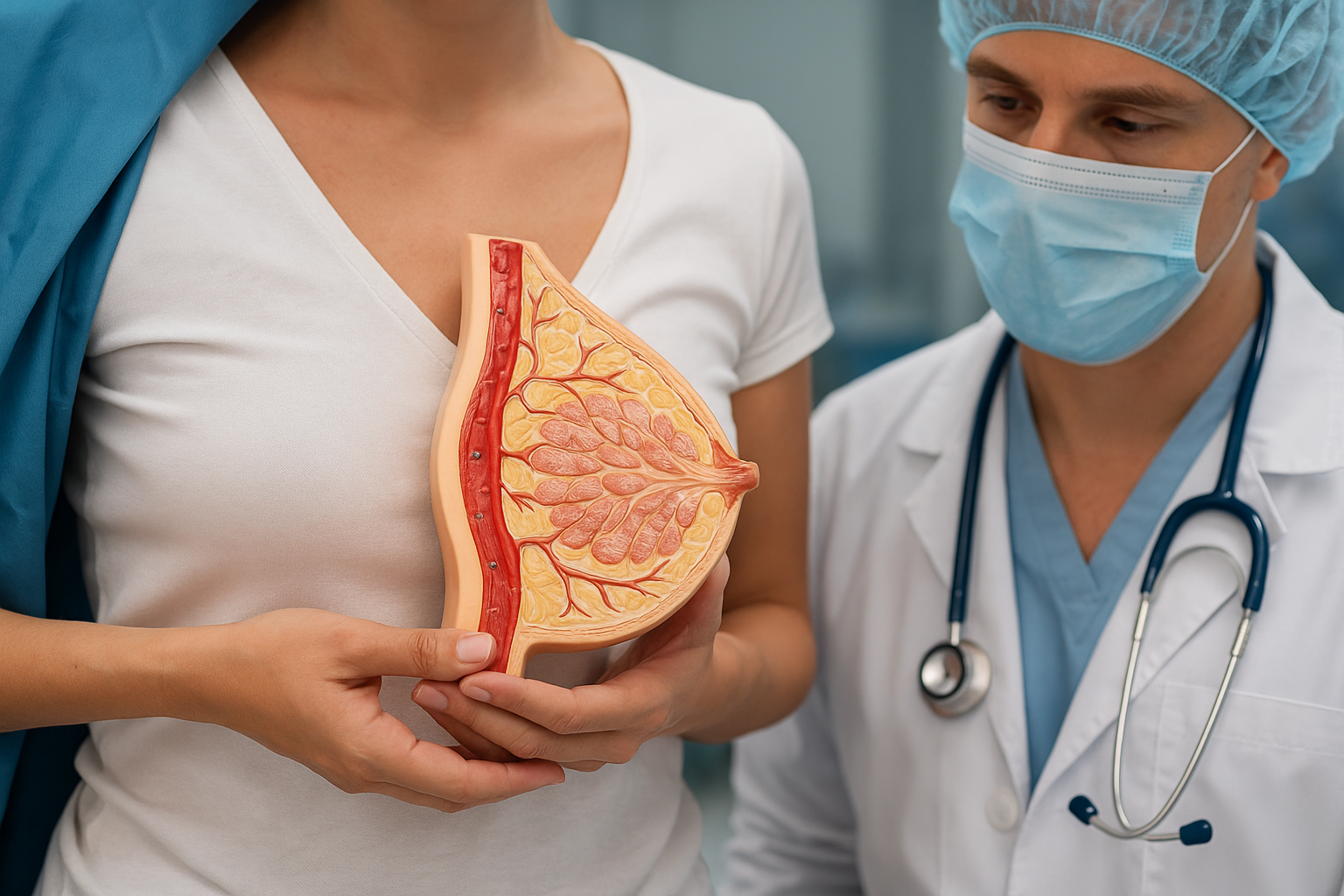Oncoplastic Surgery
- WHAT IS ONCOPLASTIC SURGERY AND WHO BENEFITS FROM IT?
- WHICH ONCOPLASTIC TECHNIQUES ARE USED IN BREAST-CONSERVING SURGERY (LUMPECTOMY)?
- WHAT ARE THE MASTECTOMY OPTIONS AND HOW IS IMMEDIATE BREAST RECONSTRUCTION PERFORMED?
- WHAT BREAST RECONSTRUCTION METHODS ARE USED IN ONCOPLASTIC SURGERY?
- HOW ARE SYMMETRY AND COSMETIC BALANCING PROCEDURES PERFORMED?
- HOW IS THE NIPPLE–AREOLA COMPLEX PRESERVED OR RECONSTRUCTED IN ONCOPLASTIC SURGERY?
- HOW IS ONCOLOGIC SAFETY ENSURED AND HOW IS MULTIDISCIPLINARY TREATMENT PLANNED?
- WHAT IS THE RECOVERY PROCESS AFTER ONCOPLASTIC SURGERY AND WHAT ARE THE LONG-TERM OUTCOMES?
Oncoplastic surgery is a modern approach that blends cancer removal with advanced plastic and reconstructive techniques, allowing patients to receive both effective oncologic treatment and aesthetically pleasing results in the same operation. This approach is designed for individuals diagnosed with breast cancer who require either partial or complete breast tissue removal, as well as those seeking symmetry after cancer-related surgery.
Unlike traditional breast cancer surgery, which often focuses solely on removing the tumor, oncoplastic surgery aims to protect the natural shape of the breast or restore it using reconstructive methods. Tumors can be removed with larger safe margins without sacrificing appearance, improving both oncologic outcomes and cosmetic satisfaction.
Candidates for oncoplastic surgery include patients undergoing breast-conserving surgery (lumpectomy), those requiring mastectomy with immediate or delayed reconstruction, and individuals experiencing deformities or asymmetry from previous surgeries. Oncoplastic techniques are individualized according to tumor size, location, breast volume, and patient expectations.
At OFM Hospital, the oncoplastic team works closely with oncology, radiology, and pathology specialists to create personalized plans that ensure cancer safety while preserving or rebuilding natural breast contours. This multidisciplinary approach helps patients maintain their body image, confidence, and quality of life throughout their cancer treatment journey.
Breast-conserving surgery (lumpectomy) aims to remove the tumor while preserving as much healthy breast tissue as possible. However, removing a wide margin of tissue may distort the breast’s natural shape. Oncoplastic techniques solve this problem by combining tumor excision with reshaping methods, ensuring both oncologic safety and aesthetic balance.
Oncoplastic lumpectomy begins with precise preoperative planning. The surgeon evaluates tumor size, its location within the breast, the patient’s breast volume, and the expected shape after tissue removal. This allows the operation to be tailored individually to each patient.
There are two main categories of oncoplastic techniques used during breast-conserving surgery:
1. Volume Displacement Techniques
These methods use the patient’s own remaining breast tissue to fill the space left after tumor removal. By reshaping, lifting, or reducing the breast, surgeons maintain a natural contour.
-
Ideal for women with medium to larger breast sizes
-
Often combined with breast reduction or lifting techniques
-
Provides cosmetic symmetry and oncologic safety simultaneously
2. Volume Replacement Techniques
If the tumor is large relative to the breast size, displacement is not enough. In these cases, tissue from nearby areas is used to fill the surgical cavity.
Common options include:
-
Lateral thoracic flaps
-
Intercostal perforator flaps
-
Local tissue rearrangement
These techniques preserve breast size and avoid deformity.
Tumors located in difficult regions—such as the lower pole, upper inner quadrant, or central breast—especially benefit from oncoplastic approaches because these areas are more prone to cosmetic distortion.
Another key component of oncoplastic lumpectomy is symmetry planning. If significant reshaping is required, the opposite breast can be lifted or reduced during the same operation to maintain balance.
Oncoplastic breast-conserving surgery enhances cancer control by allowing wider, safer excision margins while maintaining the natural shape of the breast. At OFM Hospital, surgeons combine advanced mapping, 3D planning, and precise surgical craftsmanship to ensure both oncologic success and aesthetic satisfaction.
Mastectomy—surgical removal of breast tissue—is recommended when breast-conserving surgery is not appropriate or when patients choose a more definitive approach. Oncoplastic surgery has transformed mastectomy by pairing cancer removal with advanced reconstructive techniques performed in the same operation. This approach helps patients preserve body image, maintain symmetry, and avoid the emotional impact of waking up without a breast.
There are several mastectomy types, each chosen according to tumor characteristics, breast anatomy, and patient preference:
1. Total (Simple) Mastectomy
All breast tissue is removed, but the skin and nipple–areola complex are typically excised. This approach is suitable for extensive disease where preservation is not possible.
2. Skin-Sparing Mastectomy
Breast tissue is removed while most of the overlying skin is preserved. This method provides an ideal foundation for immediate implant or flap reconstruction and results in less visible scarring.
3. Nipple-Sparing Mastectomy
The breast tissue is removed while the nipple–areola complex and skin envelope remain intact. When oncologically safe, this technique offers the most natural cosmetic outcome and is increasingly preferred.
4. Modified Radical Mastectomy
In addition to removing breast tissue, axillary lymph nodes are also removed. This is recommended when cancer has spread to the lymphatic system.
⭐ Immediate Breast Reconstruction
Reconstruction performed during the same surgery offers several advantages:
-
The patient undergoes one anesthesia and one recovery period.
-
The psychological impact of breast loss is significantly reduced.
-
Skin quality and breast shape are easier to restore when done immediately.
-
Radiation therapy planning can be integrated with reconstructive decisions.
Immediate reconstruction can be performed using:
• Breast Implants (Silicone or Saline)
Placed under the pectoral muscle or prepectorally with mesh support.
Benefits: shorter surgery, predictable shape, faster recovery.
• Autologous Tissue (Flap Reconstruction)
Uses the patient’s own skin, fat, and muscle—commonly from the abdomen, back, or thighs.
Techniques include:
-
DIEP flap
-
TRAM flap
-
Latissimus dorsi flap
Advantages: natural appearance, long-lasting results, suitable for patients who prefer implant-free reconstruction.
• Hybrid Reconstruction
Combines implants with autologous tissue for optimal shape and symmetry.
Mastectomy with immediate reconstruction is a personalized decision made through careful evaluation of cancer staging, imaging, lymph node involvement, breast size, and patient expectations. At OFM Hospital, oncoplastic surgeons collaborate with oncology teams to ensure cancer safety while delivering aesthetically natural results tailored to each patient’s body.
Breast reconstruction is a core component of oncoplastic surgery, offering patients the ability to restore breast shape after cancer treatment. Reconstruction can be performed immediately during cancer surgery or delayed until after chemotherapy or radiation therapy. The choice depends on medical, anatomical, and personal factors. Each method aims to create a natural, symmetrical, and long-lasting result.
Breast reconstruction techniques fall into three major categories:
1. Implant-Based Reconstruction
This is one of the most common and effective reconstruction options. Silicone or saline implants are placed under the pectoral muscle or in the prepectoral position using surgical mesh or acellular dermal matrices (ADM) for support.
Advantages:
-
Shorter surgical time
-
Faster recovery
-
Predictable breast shape and volume
Considered ideal for:
-
Patients with sufficient skin after mastectomy
-
Those who prefer a less invasive procedure
-
Individuals not suitable for extensive flap surgery
In some cases, a tissue expander is temporarily placed to gradually stretch the skin before inserting the final implant.
2. Autologous (Flap) Reconstruction
This method uses the patient’s own tissue—skin, fat, and sometimes muscle—from another part of the body to rebuild the breast. It provides a natural look and feel, often superior to implant-only reconstruction.
Common flap techniques include:
-
DIEP Flap: Uses skin and fat from the lower abdomen while preserving muscle.
-
TRAM Flap: Uses abdominal tissue including part of the rectus muscle.
-
Latissimus Dorsi Flap: Tissue taken from the back, sometimes combined with a small implant.
-
TUG/PAP/SGAP Flaps: Options for patients who do not have enough abdominal tissue.
Advantages:
-
More natural, long-lasting results
-
Better tolerance to radiation therapy
-
No need for future implant replacements
Ideal for:
-
Patients with sufficient donor tissue
-
Individuals seeking the most natural outcome
3. Hybrid (Combined) Reconstruction
A combination of autologous tissue and a small implant may be used when additional volume or projection is needed. Hybrid reconstruction merges the benefits of both techniques, improving contour, symmetry, and durability.
Reconstruction also includes finer aesthetic steps such as contour adjustments, fat grafting to soften edges, and shaping procedures to match the opposite breast. At OFM Hospital, each reconstruction method is tailored through comprehensive imaging, surgical planning, and collaborative decision-making to ensure results that meet both oncologic and cosmetic goals.
Achieving symmetry is one of the most important goals in oncoplastic surgery. Since cancer treatment often affects only one breast, natural balance between the two sides can be disrupted. Cosmetic balancing procedures are performed to improve harmony, restore proportion, and give patients a sense of confidence after breast cancer treatment.
Symmetry procedures may be performed during the same operation as cancer surgery (immediate symmetry) or in a later stage after healing and adjuvant treatments (delayed symmetry). The choice depends on the patient’s anatomy, tumor location, and reconstruction method.
There are three primary approaches to achieving symmetry:
1. Reduction (Breast Reduction Surgery)
If the reconstructed breast is smaller, the opposite breast may be reduced to match.
Benefits include:
-
Improved shape and proportion
-
Relief of symptoms such as neck or back pain
-
Better long-term symmetry
Breast reduction also allows reshaping of the breast tissue and repositioning of the nipple–areola complex for a more youthful and natural appearance.
2. Mastopexy (Breast Lift)
When the opposite breast is sagging or positioned lower, a mastopexy is performed to elevate the tissue, tighten the skin, and reshape the breast.
This is especially useful when:
-
Aging or weight changes cause asymmetry
-
Radiation alters one breast’s contour
-
Reconstruction creates a higher or firmer breast
A lift can be combined with small adjustments in volume or contour to ensure optimal balance.
3. Augmentation (Breast Enhancement)
If the reconstructed breast has more volume, the opposite breast can be augmented using an implant or fat grafting.
This approach helps patients achieve:
-
Improved volume match
-
Enhanced projection
-
A harmonious breast silhouette
Fat grafting may also be used to refine the reconstructed breast, soften contours, or correct minor irregularities.
In many cases, achieving symmetry requires a combination of these techniques to ensure both breasts match in size, shape, position, and fullness. Oncoplastic surgeons carefully analyze chest wall anatomy, breast dimensions, skin elasticity, and patient expectations to design the most suitable balancing plan.
At OFM Hospital, symmetry operations are integrated into the overall oncoplastic treatment strategy, ensuring that patients not only overcome cancer safely but also achieve a natural and confident appearance that supports emotional and physical well-being.
The nipple–areola complex (NAC) plays a central role in the aesthetic appearance of the breast. In oncoplastic surgery, surgeons aim to preserve the NAC whenever it is oncologically safe. When preservation is not possible, advanced reconstruction techniques allow patients to regain a natural and symmetrical appearance.
There are two primary pathways depending on the cancer stage, tumor location, and tissue quality:
⭐ 1. Nipple–Sparing Approaches
When the tumor is located away from the nipple and preoperative imaging confirms safety, a nipple-sparing mastectomy (NSM) can be performed.
In this technique:
-
The nipple and areola are left intact.
-
Only the underlying breast tissue is removed.
-
Blood supply to the nipple is protected through careful surgical planning.
-
Immediate reconstruction with implant or flap provides a natural result.
NSM is ideal for selected patients with early-stage cancer, favorable breast shape, and no involvement of the nipple ducts.
⭐ 2. Nipple–Areola Reconstruction (When Preservation Isn’t Possible)
If cancer involves the nipple or preservation would compromise safety, the NAC is removed. After healing from mastectomy or lumpectomy, it can be recreated through aesthetic reconstructive techniques.
a) Local Tissue Flaps
Small flaps of skin from the reconstructed breast are shaped into a nipple mound.
Advantages:
-
Uses patient’s own tissue
-
Provides natural texture and projection
Common methods:
-
C-V flap
-
Skate flap
-
Star flap
b) Areola Reconstruction
The areola is recreated using:
-
Skin grafts from areas with natural pigmentation (e.g., inner thigh), or
-
Medical-grade pigmentation (medical tattooing) for long-lasting color.
c) 3D Nipple–Areola Tattooing
A non-surgical technique that creates the illusion of a realistic nipple using advanced shading and color blending.
Used when:
-
Patient prefers no surgical reconstruction
-
Projection loss occurs after flap healing
-
Additional color correction is needed
⭐ 3. Fat Grafting for Aesthetic Refinement
Fat grafting is frequently used to soften contours, restore natural transitions around the NAC, and enhance symmetry after reconstruction.
Nipple–areola preservation and reconstruction are personalized processes. The surgeon must balance:
-
Oncologic safety
-
Breast shape
-
Skin thickness
-
Reconstruction method
-
Patient expectations
At OFM Hospital, oncoplastic specialists integrate surgical precision with aesthetic artistry, ensuring that NAC preservation or reconstruction blends seamlessly with the overall breast contour and provides a natural look that aligns with the patient’s needs.
Oncoplastic surgery is built on the principle that cosmetic outcomes should never compromise cancer safety. Every surgical decision—from incision placement to reconstruction method—must prioritize complete tumor removal, accurate staging, and treatment integration with oncology, radiology, and pathology teams. Ensuring oncologic safety starts long before the operation and continues throughout the patient’s entire treatment journey.
Comprehensive evaluation begins with detailed imaging, including mammography, breast ultrasound, and MRI when needed. These tools help map tumor boundaries, determine multifocality, and assess lymph node involvement. Biopsy results provide essential information about tumor type, hormone receptor status, HER2 expression, and grade. Together, these factors guide the selection of breast-conserving surgery, mastectomy, or reconstructive options.
During surgery, oncologic precision is maintained through:
-
Wide and clear surgical margins
-
Intraoperative pathology consultation to assess margins and confirm complete tumor removal
-
Sentinel lymph node biopsy to evaluate lymphatic spread with minimal invasiveness
-
Axillary lymph node dissection when needed for advanced disease
Oncoplastic techniques often allow for wider resections without deformity, reducing the risk of positive margins and re-operation.
A successful oncoplastic outcome requires synchronized planning with multiple specialists. The multidisciplinary team typically includes:
-
Breast surgeons
-
Plastic and reconstructive surgeons
-
Medical oncologists
-
Radiation oncologists
-
Radiologists
-
Pathologists
-
Genetic counselors
-
Nutrition and rehabilitation specialists
This collaborative approach ensures that reconstruction timing aligns with chemotherapy or radiation schedules. For patients requiring radiation therapy, tissue quality, implant choices, and flap durability are carefully considered to reduce complications and maintain long-term cosmetic results.
Follow-up care is equally important. Regular imaging, clinical examinations, and symptom monitoring help detect recurrence early and maintain breast health. Long-term surveillance is tailored according to cancer type, surgical method, and individual risk factors.
At OFM Hospital, oncologic safety is the foundation of every oncoplastic plan. Through a structured, multidisciplinary strategy, patients receive coordinated care that maximizes cancer control while preserving body image, emotional well-being, and overall quality of life.
Recovery after oncoplastic surgery varies depending on the type of cancer operation, the reconstruction method, and individual health conditions. Although every patient’s healing timeline is unique, the goals remain consistent: safe recovery, preserved aesthetic results, and smooth integration with ongoing cancer treatments.
In the early postoperative period, patients may experience swelling, mild discomfort, temporary bruising, or tightness around the surgical area. Pain is typically manageable with prescribed medication, and most patients begin light activity within a few days. Drain placement is common after mastectomy or flap reconstruction and is removed once fluid levels decrease.
For implant-based reconstruction, healing is usually faster, with initial recovery taking one to two weeks. Patients may resume work and daily routines relatively quickly, avoiding heavy lifting or strenuous activity until cleared by the surgeon. For flap reconstruction, recovery is longer due to the additional donor site, but it offers more natural and durable results.
Physical therapy may be recommended to improve shoulder mobility, reduce stiffness, and support lymphatic drainage—especially in cases involving lymph node surgery. Patients are also guided on scar care, wound hygiene, and posture adjustments to maintain comfort and symmetry.
Potential risks, although minimized with expert planning, may include infection, implant loss, flap complications, asymmetry, wound healing issues, or fat necrosis. Early detection and rapid management of complications are crucial for optimal outcomes.
Long-term results depend on surgical technique, tissue quality, radiation exposure, and overall health. With modern oncoplastic methods, reconstructed breasts often retain natural shape and softness over time. Implant patients may require future revisions, while flap reconstructions typically age with the body and offer stable, lifetime results.
Regular follow-up is essential. Patients undergo routine imaging, clinical examinations, and oncologic monitoring. These visits help ensure cancer surveillance, evaluate reconstruction integrity, and address any aesthetic refinements needed.
At OFM Hospital, the recovery process is supported by a comprehensive care team that guides patients from the first postoperative days through long-term follow-up. The goal is to restore physical well-being, emotional confidence, and a sense of normalcy while ensuring continued cancer safety.
Specialist Dr. Şakir Özdemir
Specialist Dr. Şakir Özdemir
Trakya University Faculty of Medicine
Istanbul Vakıf Gureba Training and Research Hospital – Psychiatry Specialist
Private OFM Hospital, Antalya
Department: Psychiatry
Education: Trakya University Faculty of Medicine
E-mail: sakir.ozdemir@ofmantalya.com
Languages: English
-
2008–2010: Cognitive Behavioral Therapy – Prof. Dr. Mehmet Zihni Sungur
-
2008–2010: Psychodynamic-Oriented Psychotherapy – Prof. Dr. Doğan Şahin
-
2008–2010: Sexual Dysfunction Therapy, CETAD Modules 1-2-3, Supervision (8 weeks)
-
2017: Alcohol and Substance Addiction Training – Republic of Turkey, Ministry of Health
-
Depression
-
Panic Disorders
-
Obsessive-Compulsive Disorders (OCD)
-
Personality Disorders
-
Social Phobia (Social Anxiety Disorder)
-
Sexual Function Disorders
-
Mood Disorders
-
Schizophrenia
-
Turkish Medical Association
-
Turkish Psychiatric Association



